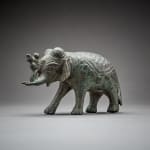Bronze Elephant, AD 1200 - AD 1600
Bronze
8.5 x 15.2 cm
3 3/8 x 6 in
3 3/8 x 6 in
OF.104
Further images
If one art-form can be considered characteristic of southern India, and especially the Tamil, then it is lost wax bronze-casting. The region of Tamil Nadu turned this difficult and time-consuming...
If one art-form can be considered characteristic of southern India, and especially the Tamil, then it is lost wax bronze-casting. The region of Tamil Nadu turned this difficult and time-consuming method of metalworking into a fine art; in fact, southern Indian bronzes are considered among India’s finest artistic achievements. Bronze working in India perhaps started in the Third Millennium BC, around the same time as in the Near Eastern ‘cradle of civilisation’. But it reached its apogee under the Chola, a Tamil dynasty which ruled much of the south-eastern Indian mainland. Coming to prominence in the Ninth Century AD, the Chola Empire survived, in one form or another, until the Thirteenth Century AD. Based on a local tradition of small bronze sculptures being the centre of Hindu devotional practice, Chola bronzes are considered some of the greatest works of Asian art, renowned for their sinuosity and dynamic, rhythmic movement. The interest in bronze, and investment in bronze-working, continued under the Chola’s successors, but from the last years of the Chola reign, the work became more schematic and programmatic.
This elephant comes from either the end of the Chola Period – before the Empire was finally defeated in AD 1279 – or from the Vijaynagara Empire which succeeded it. While lacking the sensuousness or litheness of early Chola work, this elephant is nonetheless a fine example of the bronze-caster’s art. Depicted in the act of stepping forward, he is naturalistically posed, though the proportions of his front legs are somewhat erroneous. He wears a caparison, which covers most of his back, and is designed with an elaborate fringe. Around his neck is a great thick collar, and on his head are decorated coverings which accentuate the lumps of his cranium. His ears are naturalistically formed, and posed perpendicular to the head – a position which, in real elephants, is indicative of aggression. His face, however, is relaxed and playful, and indeed he grasps two balls in his trunk, with which he appears to be playing. It is probable that at some point, this elephant had a rider, cast separately, and now missing. If this is the case, the elephant could once have belonged to Ayyanar, one of the guardian folk-deities of the Tamil.
The Tamil were one of the earliest peoples in India to domesticate the elephant. Tamil leaders were especially noted for their use of war elephants. In the Fourth Century BC, one Tamil ruler, Kuttuvan, became known as ‘Kuttuvan who has an elephant brigade as large as the clouds’ (palaanai sekelzhu Kuttuvan). Rajaraja I, perhaps the greatest of the Chola monarchs, was reputed to have had 60,000 elephants in his army. Elephants were also gifts of favour from the king to notable individuals, and especially to the bards who sang parani, a kind of epinician poetry valorising the king’s deeds. And, even today, in many temples throughout Tamil Nadu, an elephant is kept in the courtyard, where it dispenses blessings on the worshippers by touching their heads with its trunk.
This elephant comes from either the end of the Chola Period – before the Empire was finally defeated in AD 1279 – or from the Vijaynagara Empire which succeeded it. While lacking the sensuousness or litheness of early Chola work, this elephant is nonetheless a fine example of the bronze-caster’s art. Depicted in the act of stepping forward, he is naturalistically posed, though the proportions of his front legs are somewhat erroneous. He wears a caparison, which covers most of his back, and is designed with an elaborate fringe. Around his neck is a great thick collar, and on his head are decorated coverings which accentuate the lumps of his cranium. His ears are naturalistically formed, and posed perpendicular to the head – a position which, in real elephants, is indicative of aggression. His face, however, is relaxed and playful, and indeed he grasps two balls in his trunk, with which he appears to be playing. It is probable that at some point, this elephant had a rider, cast separately, and now missing. If this is the case, the elephant could once have belonged to Ayyanar, one of the guardian folk-deities of the Tamil.
The Tamil were one of the earliest peoples in India to domesticate the elephant. Tamil leaders were especially noted for their use of war elephants. In the Fourth Century BC, one Tamil ruler, Kuttuvan, became known as ‘Kuttuvan who has an elephant brigade as large as the clouds’ (palaanai sekelzhu Kuttuvan). Rajaraja I, perhaps the greatest of the Chola monarchs, was reputed to have had 60,000 elephants in his army. Elephants were also gifts of favour from the king to notable individuals, and especially to the bards who sang parani, a kind of epinician poetry valorising the king’s deeds. And, even today, in many temples throughout Tamil Nadu, an elephant is kept in the courtyard, where it dispenses blessings on the worshippers by touching their heads with its trunk.





